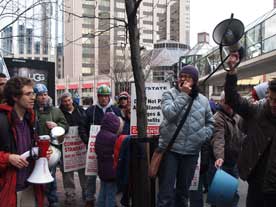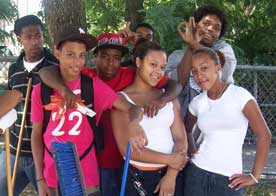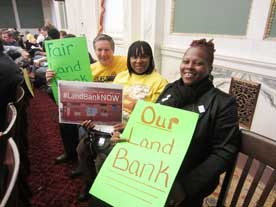Building Muscle
Lombos uses the metaphor of exercising muscles to describe what happens when community and labor organizations work together over consecutive campaigns. Each group encourages the other to stretch in new ways: “We show the community groups the value of utilizing the unions’ political relations and we show the labor unions what the community organizations get out of the streets,” she says.
The community, faith-based, and youth development organizations who participated in CLU’s first campaign, “Our Schools, Our Future,” exercised their contract negotiating muscles by joining forces with the Painters and Allied Trades District Council 35. In 2006, the coalition persuaded the Boston Public Schools district to redirect approximately $2.5 million of its building maintenance budget to establish a pre-apprenticeship program that trains and employs youth who develop skills and acquire experience while painting schools in their neighborhoods.
CLU’s second campaign, Secure Jobs, Secure Communities, launched in 2007 to organize security guards. That process reminded union members of the power of member-to-member organizing. According to Lombos, the relationships forged during that campaign have built a bridge that is solid enough to support joint organizing efforts without CLU’s additional support.
Subsequent campaigns have drawn on the strength of these well-trained muscles to form broader coalitions and pursue campaigns that aim to transform entire industries. The Green Justice Coalition (GJC), founded in 2008, brings together over two dozen community groups, environmental organizations, labor unions, and other allied organizations in support of a sustainable, equitable, and clean energy economy in the Boston region. CLU/GJC’s direct negotiations with utility companies have resulted in agreements that require the state’s largest utilities and weatherization vendors to subcontract 25 percent of all energy retrofitting projects to union contractors who hire locally and agree to pay for workers’ training. The contracts also set high standards for workplace health and safety, forbid misclassification of overtime and off-the-clock work, and compel employers to consider hiring workers who have criminal records. According to CLU’s report Building a Brighter Day, workers hired through these contracts earn approximately 45 percent more than their counterparts in the industry.
In addition to these gains in wages and job standards, the GJC has leveraged funds from utility companies to expand access to weatherization resources in working-class communities of color. These Community Mobilization Initiatives involve extensive outreach and education, streamline the process for applying for rebates, and offer subsidies for pre-weatherization building repairs.
CLU’s most recent campaign, Public Transit, Public Good, directs the force of several regional coalitions of community, environmental, and labor activists to transforming the transit systems across the state of Massachusetts. In each region, the campaign deploys strategic research, leadership development, contract negotiations, and broad-based community organizing to create good jobs for local residents while reducing carbon emissions and ensuring affordable and accessible service to people of all backgrounds.
Working and deliberating together over the course of these campaigns led CLU to broaden its shared vision. It adopted new principles that steer its efforts toward realizing a free and equitable society in which all workers enjoy freedom and self-determination in addition to better wages and working conditions.
Capturing Benefits of Growth
In Atlanta, community-labor coalitions have pursued both outsider and insider approaches to ensuring that residents benefit from the city’s large scale infrastructure projects.
Like CLU, Stand-Up convenes its community, faith, labor, and academic members to research and advocate for community benefit agreements that require developers to pay prevailing wages, expand training and apprenticeship opportunities, and commit to targeting these opportunities to local residents in addition to mitigating the impacts on traffic, public safety, and housing affordability.
In 2005, Stand-Up joined with the Atlanta North Georgia Labor Council to pressure the city council to authorize its first community benefits agreement for a major economic development project. The largest public infrastructure project in the country, the BeltLine is a 22-mile light rail transit loop that encompasses the city. The community benefits agreement promised residents of abutting neighborhoods the first chance to be hired for an estimated 48,000 construction jobs and 37,500 permanent jobs to be generated by the project. The CBA also included commitments to employ graduates of pre-apprenticeship and apprenticeship programs. Other wins included an agreement to construct 5,600 affordable housing units.
In early December 2013, the Atlanta City Council approved a comprehensive benefits plan that will direct $30 million to developing the neighborhoods around the new Falcons football stadium. This authorization follows a three-year campaign by Stand-Up and its allies that resulted in a precedent-setting requirement not to release public money for the stadium until a community benefits agreement was in place. Funding will support economic development, health and wellness programs, affordable housing, and transportation and public safety improvements.
Although the plan falls short of the more binding agreements the alliance fought for, Stand-Up successfully pressured the city council to create an advisory committee for workforce development and job training programs. Stand-Up expects to be at the forefront of the workforce strategy, and its top priorities are to identify the types of jobs and job training resources that will ensure benefits for neighborhood residents.





Comments